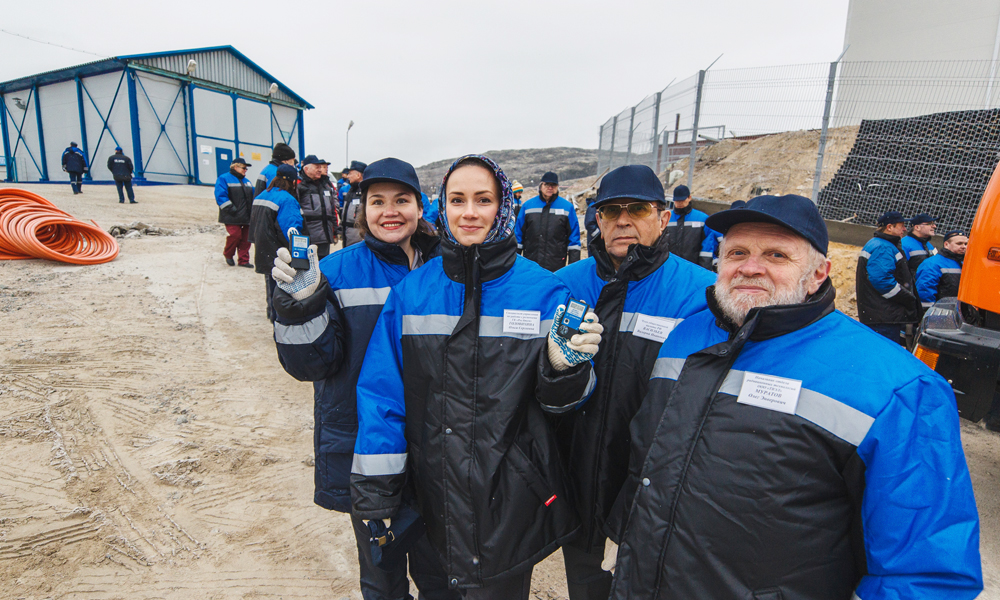
Foreign Environmental Experts Visited Andreev Bay
back to contentsIn the mid-20th century, Andreev Bay was a naval base and a fueling station for nuclear submarines of Russia’s Northern Fleet. A leak of radioactive water in 1982 earned the bay a reputation for a hazardous area. Following the cleanup effort, the accident site was used as a naval base for some more time and was closed later.
Transferred to Rosatom in 2000, the base facilities were in poor condition. Only three out of 22 buildings and structures were found usable subject to reconstruction while old facilities had to be dismantled and replaced by new ones. Major problems were posed by Building No.5 and three dry storage casks with 100 submarine reactor cores (a total of 22,000 fuel assemblies).
SNF management and removal required specific facilities and infrastructure. Norway was the first to volunteer to help. Since the late 1990s, Norway has invested 350 million Norwegian kroner into rehabilitation of Andreev Bay. The money was used to build an access road, office premises and a power supply line, install a security system (fencing and safeguarding), and erect a lighthouse to aid navigation. The construction of non-standard facilities was time-consuming and progressed slowly. “This work should be done safely to minimize potential risks as much as possible,” explained Ingar Amundsen, Head of the Norwegian Radiation Protection Authority (NRPA).
The United Kingdom was the next country to join the project. Its contribution was used to finance rehabilitation of Building No.5, build a landfill for construction waste and a storage site for construction materials, and upgrade the cabling. At present, project stakeholders are France, Germany, Japan, Italy, the USA, Canada, Finland, Denmark, and Sweden. The project is supported by the European Commission and the European Bank for Reconstruction and Development.
Almost everything is now ready to start a clean-up action in the bay. A cask transporter provided by France reached the site in spring, and a self-propelled trolley was put into operation in summer. A sheltered accumulation site for 48 containers is also ready, with 14 empty containers shipped to fine-tune the cold storage technology.
Cranes have been mounted over dry storage casks, but the storage building is still under construction. One of its sections is already equipped with a remote control panel to manage the re-loading of nuclear fuel from dry storage casks into containers.
The overall infrastructure is 80% ready, with comprehensive tests scheduled for this December and SNF removal to start next June. According to plans, the Andreev Bay rehabilitation program will be completed by 2025, turning the former secret naval base into a brownfield, i.e. a contaminated area cleaned up for industrial development. It is not clear yet how it will be used. “Certainly, we do not consider building a golf course, but using the area as a training site for equipment operators is a good idea,” said Sergei Zhavoronkin, a member of Rosatom’s Public Council.
Experts Speaking
Gennady Sklyar, Member of the Russian Parliament
— It is very important that the work at Andreev Bay is carried out in cooperation with other countries. When it comes to the world’s most serious problems, all countries must work together as it will help find a solution and develop adequate technologies.
Frederic Hauge, President, Bellona Foundation
— Major risks are posed by transportation of spent nuclear fuel to a distance of 3,500 kilometers. Surely, we do not want a ship with such a cargo to turn over. It is also important to arrange for proper waste processing at Mayak. Experts have considered all the worst-case scenarios. Our current priority is quality and safety rather than speed of the work we are doing. I think we are on the right way.
Free access to information is also crucial for success. In October, there was a leak of radioactive iodine at a pilot nuclear facility in Norway. We did not conceal the accident and informed the public. It is different with radioactive waste management though. We criticize the Norwegian government for the lack of a clear action plan on nuclear waste disposal. This work is not as large-scale as the Andreev Bay project – its costs are estimated at 11 billion Norwegian kroner. Norway plans to hire the world’s best experts, including those from Russia with a long-term expertise in nuclear waste disposal.
Fausto Santopadre, Head of Moscow Office, Sogin (Italy)
— Italy finances several projects. In particular, our money was used to build two shelters for 850 and 1,050 temporary solid nuclear waste containers. We are constructing a waste conditioning building, with a liquid waste processing facility in plans. We do not waste money when investing in a foreign project since our planet is very small and Russia is not that far away from us. I am here for the sixth time, witnessing an obvious change for the better. Now I am confident that everything will be excellent. We look forward to fuel unloading and already see, as they say, a light at the end of the tunnel.
Alexander Nikitin, Chairman, Bellona Foundation (Saint Petersburg office)
— At Andreev Bay, we have approached the stage of fuel unloading from dry storage casks. We need to be very careful when it comes to safety issues. Technologies are new, so it is important to take time. A double check will never be excessive. If needed, we will suspend the work to improve the technology. Generally, the project is complex, but interesting and implementable.




